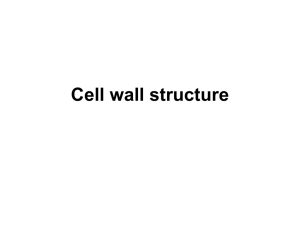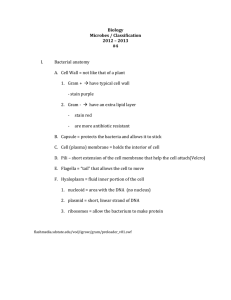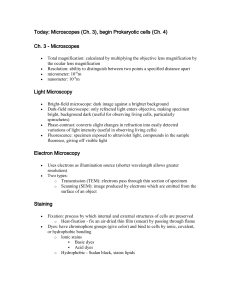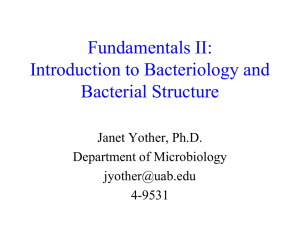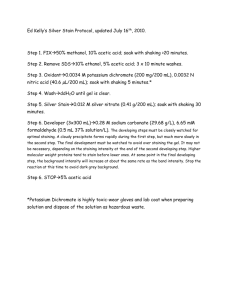Lab Exercises Week 2: #2 Pure Culture #7 Defined and Undefined
advertisement
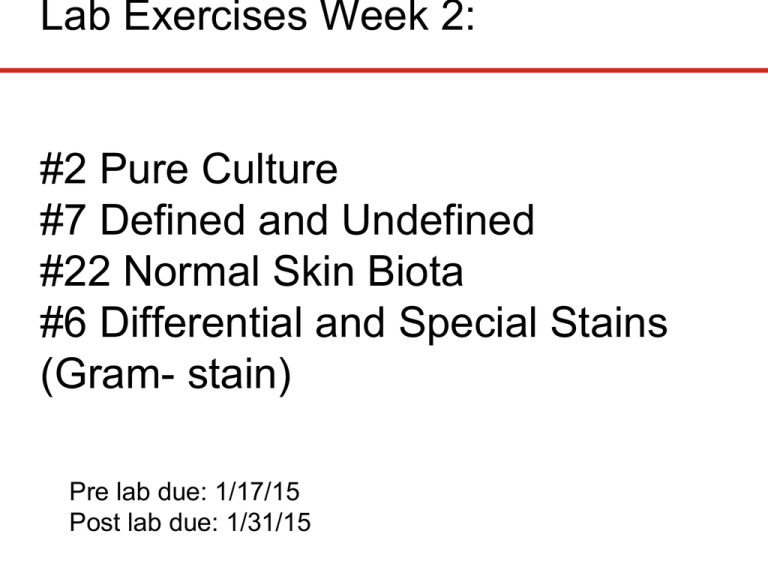
Lab Exercises Week 2: #2 Pure Culture #7 Defined and Undefined #22 Normal Skin Biota #6 Differential and Special Stains (Gram- stain) Pre lab due: 1/17/15 Post lab due: 1/31/15 4.3. Obtaining a Pure Culture Pure culture defined as population of cells derived from a single cell • Allows study of single species Pure culture obtained using aseptic technique • Minimizes potential contamination Cells grown on culture medium • Contains nutrients dissolved in water • Can be broth (liquid) or solid gel Growing Microorganisms on a Solid Medium Need culture medium, container, aseptic conditions, method to separate individual cells • With correct conditions, single cell will multiply • Form visible colony (~1 million cells easily visible) • Agar used to solidify • • • • Not destroyed by high temperatures Liquifies above 95°C Solidifies below 45°C Few microbes can degrade • Growth in Petri dish • Excludes contaminants • Agar plate Growing Microorganisms on a Solid Medium Streak-plate method • Simplest, most commonly used method for isolating • Spreads out cells to separate • Obtain single cells so that individual colonies can form Copyright © The McGraw-Hill Companies, Inc. Permission required for reproduction or display. 1 Sterilize loop. 4 Sterilize loop. 6 2 Dip loop Into culture. 3 Streak first area. 5 Streak second area. Starting point Agar containing nutrients Sterilize loop. 4.7. Cultivating Prokaryotes in the Laboratory General categories of culture media • Complex media contains variety of ingredients • Exact composition highly variable • Often a digest of proteins • Chemically defined media composed of exact amounts of pure chemicals • Used for specific research experiments • Usually buffered 4.7. Cultivating Prokaryotes in the Laboratory Hundreds of types of media available • Regardless, some medically important microbes, and most environmental ones, have not yet been grown in laboratory 4.7. Cultivating Prokaryotes in the Laboratory Special types of culture media • Useful for isolating and identifying a specific species • Selective media inhibits growth of certain species • Differential media contains substance that microbes change in identifiable way Copyright © The McGraw-Hill Companies, Inc. Permission required for reproduction or display. Colony Zone of clearing (a) (b) a: © Christine Case/Visuals Unlimited; b: © L. M. Pope and D. R. Grote/Biological Photo Service 3.2. Microscopic Techniques: Dyes and Staining Simple staining involves one dye Differential staining used to distinguish different types of bacteria 3.2. Microscopic Techniques: Dyes and Staining Acid-fast staining used to detect Mycobacterium • Includes causative agents of tuberculosis and Hansen’s disease (leprosy) • Cell wall contains high concentrations of mycolic acid • Waxy fatty acid that prevents uptake of dyes • Harsher methods needed • Used to presumptively identify clinical specimens 3.2. Microscopic Techniques: Dyes and Staining Capsule stain Some microbes surrounded by gel-like layer • Stains poorly, so negative stain often used • India ink added to wet mount is common method Copyright © The McGraw-Hill Companies, Inc. Permission required for reproduction or display. 10 m © Dr Gladden Willis/Visuals Unlimited/Getty 3.2. Microscopic Techniques: Dyes and Staining Flagella stain Flagella commonly used for prokaryotic motility • Too thin to be seen with light microscope • Flagella stain coats flagella to thicken and make visible • Presence and distribution can help in identification Copyright © The McGraw-Hill Companies, Inc. Permission required for reproduction or display. 1 m © E. Chan/Visuals Unlimited 3.2. Microscopic Techniques: Dyes and Staining Endospore stain Members of genera including Bacillus, Clostridium form resistant, dormant endospore • Resists Gram stain, often appears as clear object • Endospore stain uses heat to facilitate uptake of primary dye (usually malachite green) by endospore • Counterstain (usually safranin) used to visualize other cells Copyright © The McGraw-Hill Companies, Inc. Permission required for reproduction or display. 10 m © Jack M. Bostrack/Visuals Unlimited 3.2. Microscopic Techniques: Dyes and Staining Gram stain most common for bacteria Two groups: Gram-positive, Gram-negative • Reflects fundamental difference in cell wall structure Copyright © The McGraw-Hill Companies, Inc. Permission required for reproduction or display. Steps in Staining 1 Crystal violet State of Bacteria Appearance Cells stain purple. (primary stain) 2 Iodine Cells remain purple. (mordant) 3 Alcohol (decolorizer) 4 Safranin (counterstain) (a) Gram-positive cells remain purple; Gram-negative cells become colorless. Gram-positive cells remain purple; Gram-negative cells appear pink. (b) b: © Leon J. Le Beau/Biological Photo Service 10 µm The Gram-Positive Cell Wall Gram-positive cell wall has thick peptidoglycan layer Copyright © The McGraw-Hill Companies, Inc. Permission required for reproduction or display. N-acetylglucosamine N-acetylmuramic acid Teichoic acid Peptidoglycan and teichoic acids Gel-like material Peptidoglycan (cell wall) Cytoplasmic membrane Gel-like material Gram-positive (b) Cytoplasmic membrane Peptidoglycan Cytoplasmic membrane (a) (c) (c): © Terry Beveridge, University of Guelph 0.15 µm The Gram-Negative Cell Wall Gram-negative cell wall has thin peptidoglycan layer Outside is unique outer membrane Periplasm LPS Copyright © The McGraw-Hill Companies, Inc. Permission required for reproduction or display. O antigen (varies in length and composition) Porin protein Core polysaccharide Lipid A Lipopolysaccharide (LPS) (b) Outer membrane (lipid bilayer) Outer membrane Peptidoglycan Lipoprotein Periplasm Cytoplasmic membrane Peptidoglycan Periplasm (c) Cytoplasmic membrane (inner membrane; lipid bilayer) Outer Cytoplasmic Peptidoglycan membrane Periplasm membrane (a) (d) (d): © Terry Beveridge, University of Guelph 0.15 µm Cell Wall Type and the Gram Stain Crystal violet stains inside of cell, not cell wall • Gram-positive cell wall prevents crystal violet–iodine complex from being washed out • Decolorizing agent thought to dehydrate thick layer of peptidoglycan; desiccated state acts as barrier • Solvent action of decolorizing agent damages outer membrane of Gram-negatives • Thin layer of peptidoglycan cannot retain dye complex
